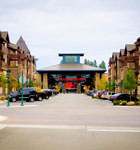At a Glance
Locations
Titusville, FL; Spartanburg, SC; Bastrop, TX
Founded
1982
Employees
150
Specialties
Power-line and fiber-optic transmission cable installation and maintenance
Average Sales
$30–40 million
When the power can’t be turned off in houses across a region but the lines need maintenance, the brave souls who do the high-wire act to repair it may be Southeast Power Corporation employees. The business was incorporated in 1982 under its parent company, the Goldfield Corporation, which has been in business for more than 100 years, and Southeast Power now installs and repairs transmission-line poles, foundations, and wires in the southeast portion of the US while taking pride in its staff.
Southeast Power is organized into four divisions: Southern, Northern, Western, and Foundation, the last of which provides support to the company’s electrical operations and independently provides foundation services to competitors and non-traditional clients. Through its various divisions, the company works on power-transmission lines and fiber-optic systems in Florida, Georgia, Alabama, Mississippi, Virginia, North Carolina, South Carolina, and now Texas. Chief operations officer John Davis notes there’s an unusual cohesion within the subgroups. “I think our company works well because of the unique ability of all four divisions to interact as one company,” he says.
Top 5 Facts About Bare-Hand Hot Work
1. The lineman’s body is maintained at the same voltage as the line.
2. As the lineman approaches the wire, an arc will form between his body and the line as his body is charged. He must immediately bond himself to the line to prevent further arcing.
3. He uses a conducting wand during the approach to make the first connection. Once on the line, he is safe from shock because both the lineman and the wire are at the same electric potential and no current passes through his body.
4. Bare-hand workers are required to wear overalls made from or woven throughout with conducting fibers to prevent the current from the strong electric field from going through them. They must also wear conducting gloves, socks, and boots.
5. Bare-hand work can be performed on any high-voltage lines. Southeast Power crews have worked bare-hand on 69,000-volt, 138,000-volt, and 230,000-volt transmission lines.
Southeast Power recently completed a “hot” project (one on a live power line) in the Florida Everglades. “A hot project doesn’t happen every day, but it’s not uncommon,” Davis says. “If it’s a high load—like where we were in the Everglades, where there was only one line [in each direction]—you’re not going to get it [shut] down.”
In that project for the local power company, Lee County Electric Cooperative, Southeast Power upgraded the Immokalee-Carnestown Line, replacing existing wooden H-frame poles with concrete ones. For four months, crews worked on this project while the 138-kilovolt conductors remained hot. Davis makes sure to acknowledge the rare individuals who want to work on hot projects. “That takes a special hot-work crew or bare-hand crew.” Davis says, explaining that bare-hand crews are so named because they’re in direct contact with electrical equipment, not because they’re literally bare-handed. “It takes a special person, a special lineman. You have to know what you’re doing.”
A recent project for CPS Energy, a rebuild of the existing Los Angeles Heights-Dresden Line, has given Southeast Power a foot in the door to the Texas market. The firm rebuilt the existing transmission line with new steel poles, which required vacuum excavation of the old poles. The project, performed outside of San Antonio, took approximately three months.
Southeast Power’s strong internal morale and work ethic—from the executives all the way down to the linemen—allow the company’s divisions to maintain a high level of process efficiency. “One of our strengths is the utilization of qualified people to provide the highest level of service to our customers,” Davis says, adding that Southeast Power crews work diligently and well together. “We may send fewer people where other companies send more. Everybody gets along as a cohesive group working as a unit. We move equipment from one division to the other and people from one division to the other to meet our customers’ needs. Everybody just wants to work, and that’s a direct reflection of the leadership of the company.”
Moving forward, the company would like to grow further westward into Texas—as well as into Louisiana, Oklahoma, and Nebraska. “Texas is big enough,” Davis says with a laugh.“I don’t know that we want to limit ourselves to a state … but we thought we’d go in the middle of the country and expand both ways.” In the meantime, he’s cautiously optimistic about the economy and the prospect of recovery. “It has the feel of the upswing,” he says, “but I’ve been saying that for a couple months. I just see more and more work coming out.” ABQ


